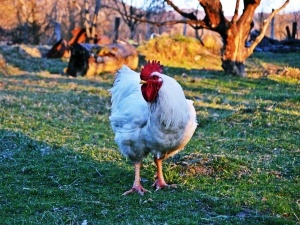
A chicken’s feathers are its crowning glory, a good-looking set of feathers communicates that the health of the bird is good. But if these feathers start to look frayed, you’d be right to be worried. This article looks into why this happens.
Table of Contents
Chicken feathers look frayed:
A change in your bird’s appearance, whether it’s a change in the bird’s body or feathers, is a sign that there is something up with the bird. The bird’s feathers may look frayed because:
Environment:
The bird’s environment may be the reason why the bird’s feathers start to look frayed.
If your bird is constantly passing through openings, like openings in barbed wire, that constantly scratch against the bird’s feathers, then over time your bird’s feathers will become damaged and will look frayed.
What to do:
Keep an eye on your bird to see if this is what is going on with your bird. Keep an eye on where the bird is going and what the bird is coming in contact with.
If the bird is rubbing against something rough, like the sharp end of a barbed wire fence, then you’d need to close this fence up to protect your bird.
The bird’s feathers will not return to normal after you close the opening but doing this will keep more damage from happening. The bird will grow new undamaged feathers after shedding the old feathers during molting.
Mites and lice:
External parasites, like lice and mites, may be the reason why your bird’s feathers are starting to look frayed.
A bird with lice or mites will constantly preen its feathers in an effort to get rid of these parasites. This excessive preening will cause breakage of the feathers and cause the feathers to look frayed.
What to do:
You’d need to examine the bird to see if it does in fact have a mite or a lice infestation.
Lice and mites are different, lice live on the bird’s body, you will find them on the bird’s body day and night. Mites, on the other hand, do not live on the bird’s body but rather in the coop and will move onto the bird’s body at night.
If you think that your bird has mites you’d need to check for these bugs at night when they feed. Use a strong flashlight/headlight to better see these insects. These insects will usually gather around the bird’s vent, neck, wings, and head.
You can also test to see if the bird is infested with these insects by rubbing the underside of the bird using a white paper towel.
If the bird does in fact have mites then you’ll see red smears on the paper towel after you wipe the bird. The red smears are smashed red mites
If you find that your bird does in fact have a parasite infestation then you’d need to use synthetic permethrin products on the bird or in the coop, depending on what the parasite is, to get rid of these parasites.
If your bird has lice then you’d need to use this product directly on your birds, if your bird has mites then you’d need to use the poultry dust in the coop.
Fighting with other birds:
The other birds in the coop may be the reason behind the frayed feathers of one of your birds. You may have one bird, or a few birds, who pick at or pull one of your bird’s feathers causing the bird’s feathers to start looking frayed.
What to do:
Observe the birds to see if they are in fact picking on one of your birds and pecking the bird’s feathers and causing them to look frayed.
If one of your birds is bullying another then you either have to isolate the bully bird to get the aggression out of it, or, you may need to get rid of the bully bird if its behavior can’t be changed.
Low protein diet:
Proteins are the building block of your bird’s wings. This mineral is essential if you want your bird to grow strong feathers.
If your bird’s diet is lacking in protein then the birds feathers won’t be strong in the first place and can start looking frayed quite early on.
A lack of protein may develop if your bird is fed too much scratch. Scratch is a treat, chickens love it, but this food is too low in protein to be a staple food for birds.
If given the chance, birds will eat the scratch, become full, and won’t want to eat nutrient-rich foods which contain adequate amounts of protein in them.
What to do:
Check that your bird is indeed eating enough protein in its diet. If the bird is not getting enough then you can add more protein into the bird’s diet by giving the bird sources of protein like mealworms, scrambled eggs, and insects.
If you enjoyed this article then you may also be interested in other chicken related articles. Here are some articles that you may be interested in: Nutri-Drench For Wry Neck, Chicken Comb Looks Dry, Rooster Walking Backwards

